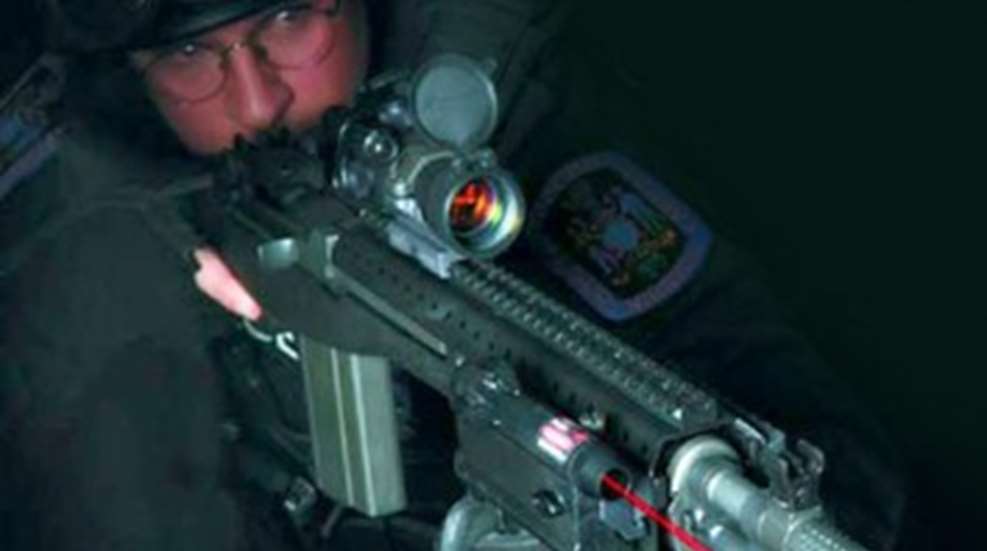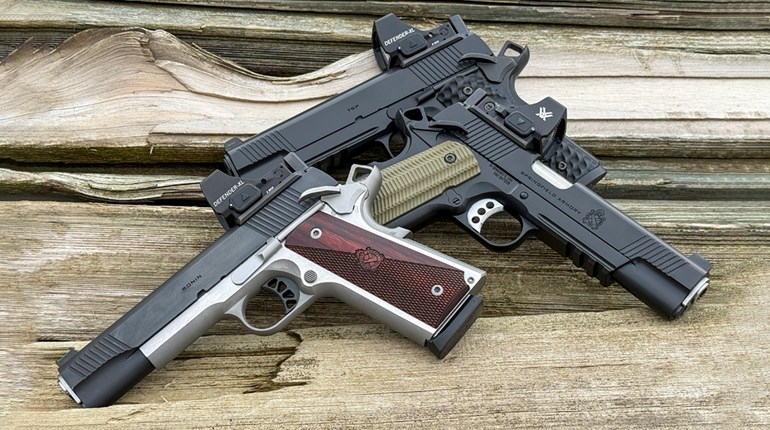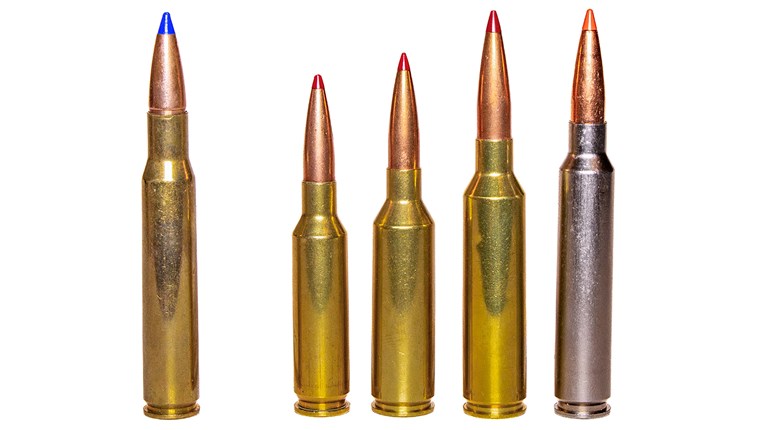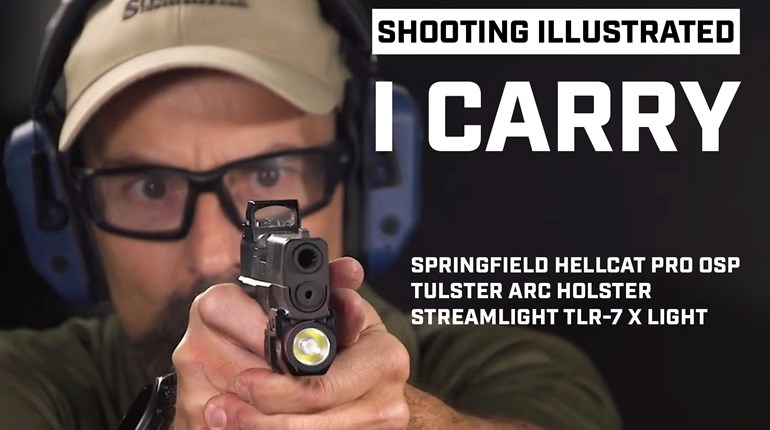
A decedent of John Garand's M1, the M14 was first adopted by the Army in 1957. It served a relatively short tour in the U.S. military, as it was soon replaced by the M16 during Vietnam, and seemingly forever relegated to ceremonial parade decks and the world of competitive shooting thereafter. But along the way, a couple of pivotal events changed the way we look at the M14. First, the Navy and Marine Corps retained inventories of the M14 for field use, and eventually Marine Designated Marksmen put the M14 to even better use as a scoped, semi-automatic-only version in a McMillan M2A stock.
Fast forward to the modern-day battlefields of Afghanistan and Iraq, where Special Forces personnel in theater brought stocks of the M14 out of mothballs in order to have a rifle better suited for long-range fire that is effective on targets. Especially in Afghanistan, where the terrain is mountainous and the operations often covert, reports of the ineffectiveness of the 5.56 NATO round gave way to the comeback of the tactical M14. I even heard one unconfirmed story of an operator taking an M14, hacking off the barrel and crowning the muzzle in the most field expedient of ways—with a rock! I don't know if that's true or not, but if so, too bad he couldn't have waited for a SOCOM 16, which is what he allegedly wildcatted in the crudest of ways.
While the military kept its on-again, off-again relationship in question with the M14, in the late '70s and early '80s, the Springfield Armory name was reborn, and the company began to acquire a reputation for its match-grade M1A. By 1997 Springfield released the M1A Scout Squad, with a walnut, fiberglass or laminated stock, 18-inch barrel, Scout mount and muzzle stabilizer. An outgrowth of the earlier M1A Bush Rifle, the Scout Squad claimed a spot within the tactical community. And why not? It is a smaller, lighter and more maneuverable arm than its bigger brother, and its debut didn't come without precedent. Think back to World War II and the most famous battlefield weapon ever carried by American soldiers—the M1 Garand. Even though it was widely appreciated for both durability and design, there was still a place for the tanker version. Experience taught the military that certain battlefield applications could be better served with a smaller, more maneuverable rifle, and American law enforcement personnel would eventually follow suit in their pursuit for contemporary tactical carbines.
So Springfield Armory sought out to further improve upon the idea within its own well-established M1A product, and the SOCOM 16 was born. The most obvious change came with the shortened 16-inch barrel, giving the SOCOM a decidedly tactical look and feel. But shortening a .30-caliber rifle has consequences regarding recoil management, and operators today compare everything against the M16 and its variants, which benefit from the light recoil of the 5.56 mm NATO—Springfield had to do something about the increased muzzle flip.
To mitigate those forces, Springfield devised a proprietary muzzle brake that defies all expectations—you just can't believe how well it works until you rack the bolt and send some rounds downrange. "The bottom portion of the unit—from 3 o'clock to 9 o'clock—is solid, but the upper portion is pierced by six rows of ports, with a total of 34 holes," said Wiley Clapp, in the August 2004 American Rifleman. "Gas vented up in this way tends to reduce the upward flip of the muzzle." With a proper stance, leaning into the gun while pulling the rifle firmly into the shoulder pocket, a shooter can easily keep the sights within a man-sized target at extended range as he rapid-fires through a magazine of 7.62 mm NATO (.308 Winchester). The advantage is very clear: Target acquisition for follow-up shots are multiple targets is drastically improved by the effective design of the compensator. For law enforcement or military personnel, target acquisition is paramount, making the SOCOM highly accepted within the tactical community.
The SOCOM 16 wears a one-piece, black, fiberglass stock, which has been finished with black crinkle paint. The feeling it gives is of one sexy, mean little carbine. The result is a surface that exhibits a considerable amount of tackiness, allowing a consistent purchase through all types of weather conditions and environments.
Also functional in various environments, succeeding especially well in conditions of low ambient light is the XS 24/7 Tritium Strip blade, which rests between two ears. Combined with a military-style .125-inch rear ghost-ring sight, the SOCOM 16 delivers a lightning quick sight picture for engaging targets.
Beneath it all beats the heart of the original M14. The SOCOM 16 is a rotating-bolt, gas-operated, air-cooled rifle, and with all that steel, even with the chopped barrel, it still weighs in at 8.9 pounds. It's also able to feed reliably from a multitude of detachable box magazines, from the ban-era five- and 10-round versions to the full-capacity, 20-rounders.
And it's a good thing, because once you mount a red-dot sight above the forward scout mount, you're going to need all the rounds you can get. The clear and immediate target acquisition of an optic above the SOCOM 16 inspires a lot of shooting. Whether on the bench or engaging targets on a movement course, the SOCOM 16 is a pure joy to shoot—and shoot a lot.
But it's here where the new story begins. The second-generation SOCOM 16 has upped the ante, and it might be this new version that takes the tactical community by storm. While the original made quite an impact with the forward-mounted scout rail, the fore-end of the second generation is virtually covered in Picatinny rails. Where before operators had the option of only a single accessory, now the SOCOM 16 can accommodate everything a tactical operator could desire. My test gun came complete with an AimPoint red-dot sight, SureFire flashlight and an Insight Technology PAQ-4 laser with touch pad remote attached to a fore-end pistol grip. And man does it look mean with all that high-speed gear.
In our own "Gun Locker" review of the original SOCOM 16 in August 2004, I proposed the following: "Ultimately, the SOCOM does to the M14 what the M4 did to the M16—it delivers a smaller, lightweight version of its former self, capable of delivering effective fire at extended ranges, while maintaining its tactical maneuverability. For dedicated fans of the M14, it does all that and more."
If that's true, then the next generation of the SOCOM only further perpetuates the ideal. With the addition of the advanced Picatinny rail system, the SOCOM now has the potential to match the M4 in tactical versatility. Operators have the ability to take what is essentially an M14, hang every tactical tool they may have at their disposal, and arrange it in such a way that previously only the M4 has done at such a high level of flexibility.
That dependable versatility owes itself entirely to the Picatinny rail system, which is made from aluminum, with stronger steel attachment points within, developed to Springfield Armory's specifications. It will currently only be offered as an integral part of new SOCOMs, but eventually Springfield will offer the rail system as an aftermarket accessory capable of being fitted to original SOCOM 16s. The rail system is also modular, and future versions will allow users to develop and configure the rail to specific tactical needs. This is especially important to law enforcement personnel, where procedures often determine what configuration of accessories can be used in tactical scenarios.
A collapsible stock version is also under development. Early rumblings had pointed to a design similar to the M4, but for now we're left to only wonder exactly how the SOCOM 16's shorty stock will look and function in the future. This actually gives Springfield the opportunity to do something truly innovative with the collapsible buttstock, but whether they emulate the M4 or come up with a proprietary design remains to be seen. But we do know there is already another stock finish available, and it's equally likely to raise eyebrows. Touted as Urban Camo, at first glance it's as stunning as the rifle itself, and certainly adds another dimension to an awesome rifle.
But the stock finish was the excellent performance turned in on the range. Since last spring I have put a tremendous amount of rounds through both versions of the SOCOM. During the initial testing after the SOCOM 16's debut, I managed to confine myself to the shooting bench long enough to produce some groups, which averaged around one inch. That was all I needed to dismiss the bench shooting and head to the fun stuff. After throwing up man-sized silhouette targets I quickly ran through a few hundred rounds, firing from virtually every shooting position and on the move. It was here that the value of the muzzle brake became readily apparent—you could just keep yourself tied into the gun better than expected with 7.62 recoil.
When I received the second-generation SOCOM, it was essentially like firing a completely new rifle. All the operating controls were in the same locations, and nothing in the handling or mounting of the rifle was appreciably different other than weight, but what was different was the plethora of manners in which I could engage targets. While I used only a red-dot sight previously, which I replicated on the second-generation with an Aimpoint, I was also able to turn off the lights and fully engage targets utilizing either the SureFire or PAQ-4 laser. Whether through the Aimpoint or with iron sights, the second generation SOCOM is indeed a different animal. This happens to bring up one of the few complaints, one shared by virtually all rifles of this type, which comes with gaining a proper cheek weld after the addition of an optic. Since the M14 was not originally designed to use an optic, it's tough to gain the proper line of sight with the optic so high above the top line of the receiver. For many shooters, some type of aftermarket cheekpiece may be required. But it's worth it; the SOCOM's combinations are endless: light and iron sights; laser and red-dot sight; light and red-dot sight—you name it. When you add in the factor that the rail system can be manipulated to fit precise law enforcement training and operating procedures, the second-generation SOCOM 16 becomes an enviable rifle choice for the modern tactical operator.
Better yet, it delivers the goods aboard a .30-caliber rifle. Regardless of what argument is made in favor of the 5.56 mm Nato—of which I am a fan—ballistically it just doesn't match the 7.62's stopping power. I think the 5.56 has proven it can do the job, but there are circumstances where it comes up short. Anything from extended range to a spare magazine in the pocket of a combatant has shown to minimize the effect of the 5.56. Shouldering a carbine chambered for 7.62 arguably lessons those concerns.
But be prepared, because it's chambered for the beefier cartridge, and with the addition of the huge Picatinny rail system, the second generation SOCOM 16 tips the scale at a whopping 10 pounds, 7 ounces—without any of the accessories or ammo. Adding a full, 20-round magazine piles on an additional 1 pound, 9 ounces, and lights, lasers and red-dot sights will keep the scale climbing as well. This is where the M4 still shines, with various flattop carbines coming in as much as three pounds lighter. And like the M4, when all the accessories are hung on the SOCOM, it puts much of the weight well forward, which leads to more rapid fatigue of the fore-end arm. But this rifle is made with law enforcement personnel in mind, so they should be able to handle the load.
Ultimately, that's the niche I expect the second generation SOCOM 16 to fill—and fill it well. It's made with the tactical scenario in mind. For most civilians, the standard SOCOM 16 remains a better choice. With the single scout mount, a red-dot sight or long eye relief scope is all most will ever need. But as the modular rail system and accessories continue to be developed, its possible more civilians will find they can configure the rail to their specific needs—such as only placing a Picatinny rail on the bottom to accommodate a SureFire tactical light or pistol grip.
Last year the SOCOM 16 debuted with a boom, and many within the industry immediately dubbed it the ultimate ranch rifle, perfectly suited for tactical or home-defense use. I echoed that then, as I do now, and the second-generation SOCOM may equal its predecessor in praise as the ultimate law enforcement carbine. The addition of a versatile, modular Picatinny rail system at least puts it on the right track to challenge the M4 Carbine. And as the package completes itself with a collapsible stock and future modular rail options, we're only now just beginning to scratch the surface of the SOCOM 16's potential.




































